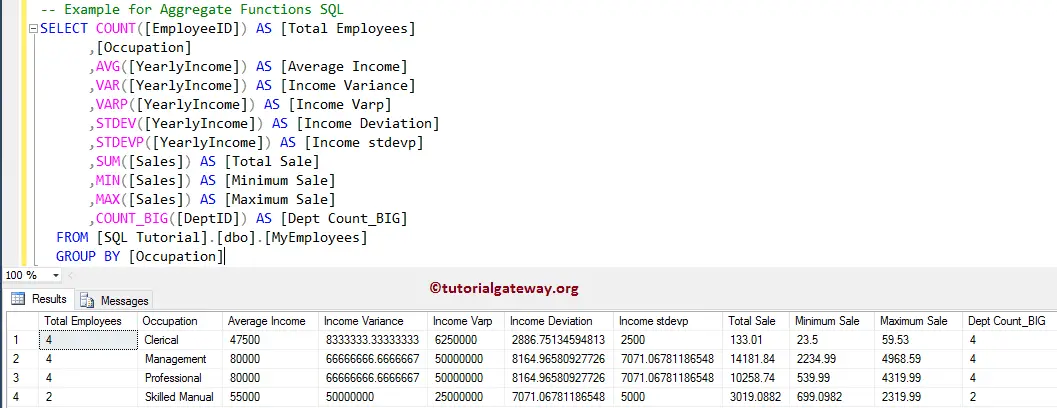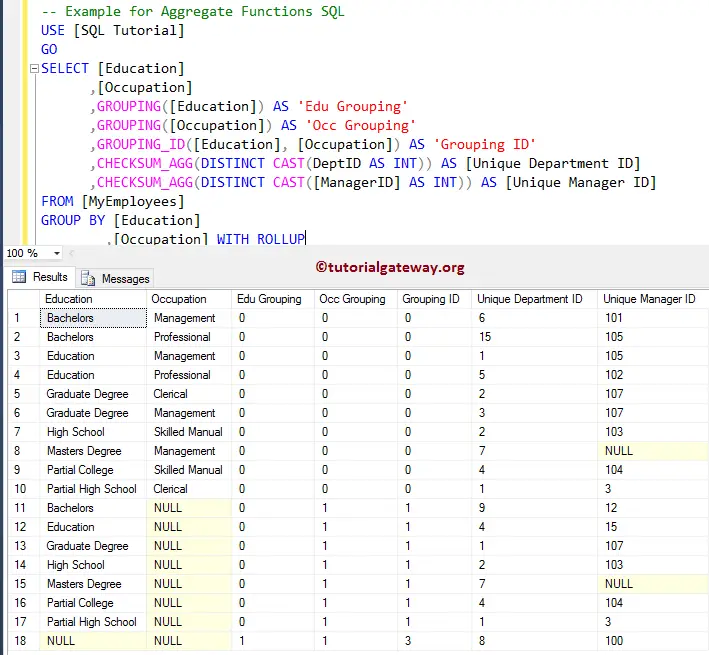The SQL Server provides various Aggregate Functions, which allow us to perform aggregations such as calculating the average, sum, minimum, maximum, count, etc.
SQL Aggregate Functions
The Aggregate functions are used to extract the accumulated, total, or high-level data. For instance, the total regional sales, product sales by country, etc.
To use these SQL functions, you have to use the Group By Clause for the non-aggregate columns. Otherwise, it will throw an error.
The following table will show you the list of available Aggregate Functions. If you want to use any expressions to restrict the records, then use the Having Clause, not the Where Clause.
| Functions | Description |
|---|---|
| AVG | It will calculate the Average of total records (or rows) selected by the SELECT Statement. |
| CHECKSUM_AGG | It is used to return the checksum of the values in a Group. |
| COUNT | It will Count the number of records chosen by the SELECT Statement. |
| COUNT_BIG | It works the same as the COUNT function, but it returns the bigint. |
| GROUPING | It is used to indicate whether or not the specified column in a GROUP BY Clause is aggregated. |
| GROUPING_ID | This SQL Server function is used to return the level of grouping. |
| MAX | It returns the Maximum value from the chosen total records. |
| MIN | It returns the Minimum value from the total rows selected. |
| STDEV | Calculates the Standard Deviation of the selected records. |
| STDEVP | It is used to calculate the Standard Deviation for the population. |
| SUM | The Total or Sum of rows picked by the SELECT Statement. |
| VAR | Statistical Variance of selected records. |
| VARP | Statistical Variance for the population. |
SQL Aggregate Functions Example
The following query will show you some SQL Server aggregate functions such as AVG, VAR, VARP, STDEV, STDEVP, SUM, MIN, MAX, and COUNT.
SELECT COUNT([EmployeeID]) AS [Total Employees]
,[Occupation]
,AVG([YearlyIncome]) AS [Average Income]
,VAR([YearlyIncome]) AS [Income Variance]
,VARP([YearlyIncome]) AS [Income Varp]
,STDEV([YearlyIncome]) AS [Income Deviation]
,STDEVP([YearlyIncome]) AS [Income stdevp]
,SUM([Sales]) AS [Total Sale]
,MIN([Sales]) AS [Minimum Sale]
,MAX([Sales]) AS [Maximum Sale]
,COUNT_BIG([DeptID]) AS [Dept Count_BIG]
FROM [MyEmployees]
GROUP BY [Occupation]

The remaining list of SQL aggregate functions that includes Grouping, checksum_agg, and Grouping_id are:
SELECT [Education]
,[Occupation]
,GROUPING([Education]) AS 'Edu Grouping'
,GROUPING([Occupation]) AS 'Occ Grouping'
,GROUPING_ID([Education], [Occupation]) AS 'Grouping ID'
,CHECKSUM_AGG(DISTINCT CAST(DeptID AS INT)) AS [Unique Department ID]
,CHECKSUM_AGG(DISTINCT CAST([ManagerID] AS INT)) AS [Unique Manager ID]
FROM [MyEmployees]
GROUP BY [Education]
,[Occupation] WITH ROLLUP

